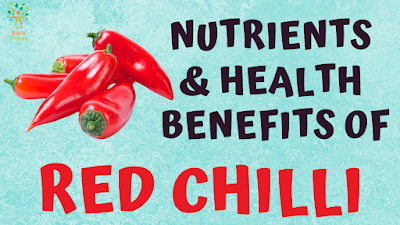Red Chilies : The Nutrients and Health Benefits of Red Chilies
Red Chilies, with their fiery flavor and vibrant hue, are a staple in many cuisines around the world. Beyond their role in spicing up dishes, these small peppers offer a host of health benefits and are packed with essential nutrients. In this article, we'll explore the nutrient profile and the potential health advantages of including Red Chilies in your diet.
A Spicy Nutrient Profile:
Red Chilies provide an array of essential nutrients in a tiny package. A one-ounce (28-gram) serving of dried Red Chili peppers contains approximately:
- Calories: 29
- Fiber: 1.1 grams
- Vitamin C: 48% of the daily recommended intake
- Vitamin A: 13% of the daily recommended intake
- Vitamin B6 (Pyridoxine): 7% of the daily recommended intake
- Potassium: 3% of the daily recommended intake
- Iron: 2% of the daily recommended intake
It's important to note that Red Chilies are also a rich source of capsaicin, the compound responsible for their characteristic spiciness. Capsaicin is linked to many of the health benefits associated with Red Chilies.
Health Benefits:
Pain Relief:
Capsaicin in Red Chilies acts as a natural pain reliever by reducing the transmission of pain signals to the brain. Topical capsaicin creams are often used to alleviate conditions like arthritis, muscle pain, and neuropathic pain.Weight Management:
Consuming Red Chilies may boost metabolism and promote weight loss. Capsaicin can increase thermogenesis (heat production) in the body, helping burn more calories.Heart Health:
The antioxidants in Red Chilies, particularly vitamin C, help combat free radicals and reduce the risk of heart disease. Additionally, capsaicin may lower blood pressure and improve cholesterol levels.Digestive Health:
Contrary to popular belief, Red Chilies may aid digestion. They can stimulate the production of stomach acid and enhance nutrient absorption. Some people find that moderate consumption of spicy foods helps alleviate symptoms of indigestion.Anti-Inflammatory Properties:
Capsaicin exhibits anti-inflammatory effects, which can be beneficial for conditions involving chronic inflammation, such as arthritis.Pain Management:
Topical capsaicin creams are used to alleviate pain associated with conditions like shingles and diabetic neuropathy. It works by desensitizing pain receptors in the skin.Enhanced Immunity:
The high vitamin C content in Red Chilies supports the immune system by helping the body produce white blood cells and fight off infections.
Incorporating Red Chilies:
Red Chilies can be incorporated into your diet in various ways:
Cooking:
Add chopped or powdered Red Chilies to curries, soups, stir-fries, and marinades for an extra kick of flavor and health benefits.Sauces:
Create spicy sauces and salsas by blending Red Chilies with other ingredients like tomatoes, onions, and garlic.Infused Oils:
Make your own chili-infused oil by steeping dried Red Chilies in olive or vegetable oil. This can be drizzled over dishes for added flavor.Drying:
Dry Red Chilies at home to make chili flakes or powder that can be sprinkled on a variety of dishes.
Cautions:
While Red Chilies offer numerous health benefits, their spiciness can be too intense for some individuals, leading to digestive discomfort or exacerbation of certain medical conditions. Start with smaller amounts and gradually increase your tolerance if you're not accustomed to spicy foods. Consult a healthcare professional if you have concerns about incorporating Red Chilies into your diet, especially if you have a medical condition that may be affected by capsaicin.
Conclusion:
In summary, Red Chilies are more than just a spice; they're a nutrient-rich addition to your diet with a range of potential health benefits. From aiding digestion to boosting metabolism, these fiery peppers can add a delicious and healthy kick to your culinary adventures.





